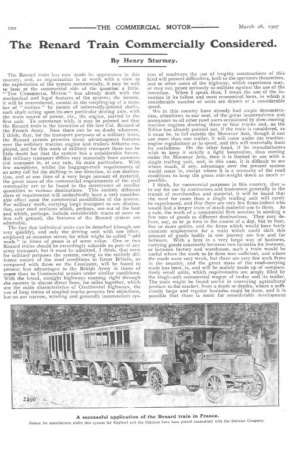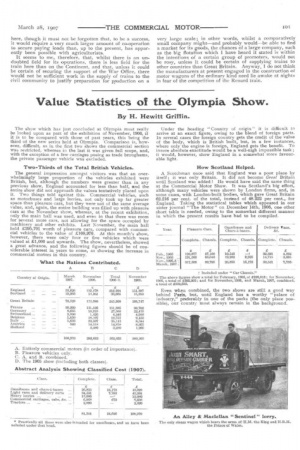The Renard Train Commercially Considered.
Page 16

Page 17

If you've noticed an error in this article please click here to report it so we can fix it.
By Henry Sturmey.
The Renard train has now made its appearance in this country, and, as organisation is at work with a view to the exploitation of the system commercially, it may be well to look at the commercial side of the question a little. " THE COMMERCIAL Moron" has already dealt with the mechanical and legal features of the system ;. the former, it will be remembered, consist in the coupling-up of a number of " trailers " by means of universally-jOinted shafts, each shaft acting upon its own particular driving axle, with the main source of power, viz., the engine, carried in the first unit. To commence with, it may be pointed out that the Renard train is the invention of the late Col. Renard of the French Army. Now there can be no doubt whatever, I think, that, for the transport purposes of a military train, the Renard system presents many advantageous features over the ordinary traction engine and trailers hitherto employed, and for this work of military transport there can be little doubt but that the system has a considerable future. But military transport differs very materially from commercial transport in, at any rate, its main particulars. With few exceptions, whilst the baggage-train requirements of an army call for the shifting in one direction, to one destination, and at one time of a very large amount of material, the great mass of the commercial requirements of the civil community are to be found in the conveyance of smaller quantities to various destinations. This entirely different class of requirement will undoubtedly have a very considerable effect upon the commercial possibilities of the system. For military work, carrying large transport to one destination, over road surfaces which, perhaps, are not of the best and which, perhaps, include considerable tracts of more or less soft ground, the features of the Renard system are admirable.
The fact that individual units can be detached (though not very quickly), and only the driving unit with one other, employed as occasion serves for what might be called "odd work" in times of peace is of some value. One or two Renard trains should be exceedingly valuable as part of any army transport, but it must be admitted, I think, that even for military purposes the system, owing to the entirely different nature of the road conditions in Great Britain, as compared with those on the Continent, will be found to present less advantages to the British Army in times of peace than to Continental armies under similar conditions. With the broad, straight highways running right through the country in almost direct lines, for miles together, which are the main characteristics of Continental highways, the use of long trains of coupled trucks presents few objections, but on our narrow, winding and generally inconvenient sys tem of roadways the use of lengthy constructions of this kind will present difficulties, both to the operators themselves, and to other users of the highway, which experience may, or may not, prove seriously to militate against the use of the invention. When I speak thus, I mean the use of the invention in its fullest and most economical form, in which a considerable number of units are drawn at a considerable speed.
We in this country have already had ample demonstration, oftentimes to our cost, of the great inconvenience and. annoyance to all other road users occasioned by slow-moving traction engines drawing three or four trucks and, as the Editor has already pointed out, if the train is considered, as it must be, to fall outside the Motorcar Acts, though it can use more than one trailer, it will come under the tractionengine regulations as to speed, and this will materially limit its usefulness. On the other hand, if its manufacturers wish to keep it strictly a light locomotive, thus coming under the Motorcar Acts, then it is limited to use with a single trailing unit, and, in this case, it is difficult to see where much, if any, advantage over the present system would come in, except where it is a necessity of the road conditions to keep the gross axle-weight down as much possible.
I think, for commercial purposes in this country, that 'is to say for use by contractors and tradesmen generally in the transit of merchandise and material, it will be found that the need for more than a single trailing unit will rarely be experienced, and that there are very few firms indeed who would find a longer train of much material use to them. As a rule, the work of a commercial firm consists in sending a few tons of goods to different destinations. They may deliver, say, 20 or 30 tons in the course of a day, but to four, five or more points, and the firms which would have fairly constant employment for a train which could shift this amount of goods bodily in one journey are few and far between. With a firm in a very large way of business, carrying goods constantly between two factories for instance, or between factory and warehouse, such a train would be useful where the work to be done was sufficient, and where the roads were very weak, but there are very few such firms in the country, and the great mass of the road-carrying trade has been, is, and will be mainly made up of comparatively small units, which requirements are amply filled by the single-unit commercial wagon of to-day and its trailer. The train might be found useful in conveying agricultural produce to the market, from a depot or depots, where a sufficiently large and regular business could be done, and it is possible that there is room for considerable development
here, though it must not be forgotten that, to be a success, it would require a very much large' amount of co-operation to secure paying loads than, up to the present, has apparently been possible with agriculturists.
It seems to me, therefore, that, whilst there is an undoubted field for its operations, there is less field for the train here than on the Continent, and that, unless it could be certain of securing the support of the War Office, there would not be sufficient work in the supply of trains to the civil community to justify preparation for production on a very large scale ; in other words, whilst a comparatively small company might-and probably would-be able to find a market for its goods, the chances of a large company, such as the big flotation which I have heard it stated is within the intentions of a certain group of promoters, would not be rosy, unless it could be certain of supplying trains to other countries than Great Britain. Anyway, I do not think the manufacturers at present engaged in the construction of motor wagons of the ordinary kind need lie awake at nights in fear of the competition of the Renard train.
























